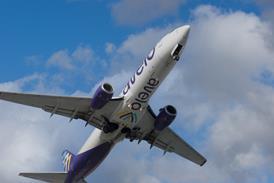The airline with the highest margins in the US is built on a simple premise: serve the customers that nobody wants, from the airports that nobody wants, with the planes nobody wants. That, in the words of Allegiant Air chairman and chief executive officer Maurice Gallagher, is the way the carrier has made a niche no one else can approach.
Allegiant, based in Las Vegas, has just unveiled plans for a new base operation at Los Angeles in line with its strategy of linking a few well-known warm-weather destinations like Phoenix or Orlando with many little-known spots like Rockford, Ill., or Grand Island, Neb. It will roll-out a dozen routes from Los Angeles during May as part of the development.
With its operating margin hitting 23% in the fourth quarter, Allegiant's strong financial performance has been one of the few bright spots for investors, and when Gallagher rang the opening bell at the NASDAQ exchange in early February, it was a highlight for an otherwise gloomy market.
 |
|---|
So desirable is the carrier that it hosts its own annual route development conference, a session attended the other week by some 120 airports, each of which made a pitch for new or expanded Allegiant service. At many of its airports, Allegiant is the only commercial carrier.
Last year, when fuel prices made the entire industry into a betting game, Allegiant had to withdraw service or suspend some frequencies, but now "we want to capitalise on on our improving revenues and return to double-digit growth levels," says Gallagher. Allegiant added 18 new routes in the fourth quarter, and will grow again this year, by as much as 5%, in this quarter and as much as 21% in the second quarter. The airline is now the largest buyer of the Boeing MD-80 in the world, Gallagher says. It expects to operate 41 of the aircraft by the end of the first quarter and 43 by the end of this year. It had 38 of Boeing MD-80s at the beginning of the year.
Its fourth quarter, despite the wild gyrations of fuel, produced a 40% gain in operating revenue and let the carrier post a double-digit operating margin for the year. "Similar to prior quarters, we had tuned the airline to handle high fuel prices as evidenced by the year-over-year reductions in capacity and by substantial increases in passengers per departure, load factors and average air fare," says Gallagher.
Gallagher tells investors that Allegiant has avoided fuel hedging "because we don't understand it and it's not our business". And it has already begun enjoying the benefits of this decision, paying lower prices for oil without having to pay off any hedging costs. Allegiant's fourth-quarter fuel price was down 21% year-over-year and helped pave the way for profit to surge by more than 280% year-over-year, from $4.8 million to $18.2 million.
The carrier's average fare declined by a blip (about 50 cents) last year to $85, but Gallagher says he is proudest of Allegiant's growth in ancillary revenues. Ancillary revenue spiked by 61% in the fourth quarter and 55% for the calendar year. By this he does not mean the hotel room and car rentals but "unbundling product categories such as seat assignments, priority boarding, airport baggage fees and our own unique Trip Flex insurance substitute policy. That not to say that hotels, rental cars and attraction tickets aren't important but the balance across all small cities and destinations from unbundling is extremely gratifying," he says.
One of Gallagher's key messages is that Allegiant may be based in Las Vegas but is not a Las Vegas airline. The gaming resort, where business has suffered dramatically, will be down to about a third of all Allegiant departures this quarter. Gallagher says: "People think that because Las Vegas itself is suffering, that we're going to suffer. Our people come from outside Las Vegas and don't live in Las Vegas, so there are some frustrations on our part as we look out at the investors' world and they just can't understand how we can continue to produce good loads at prices that make sense for us."
The Allegiant route network has long emphasised the little towns and its focus cities, Las Vegas, Phoenix, Fort Lauderdale, the Tampa Bay area and Bellingham, WA. It has thrived bringing people from their cold weather homes in Plattsburgh, NY, or Casper, WY, to sunny resorts for few days. This, though, is undergoing a change: increasing demand comes from people living in Florida, Phoenix and Las Vegas using Allegiant to visit their friends and relatives in their hometowns. "This type of traffic is much more resilient in an economic downturn," says Ponder Harrison, Allegiant's managing director-marketing and sales. "We serve points in small markets that, really, there is just no other way to get to."
Source: Airline Business























